- The African community in Guangzhou, China, is in crises with Africans being left homeless, have become targets of suspicion, and subjected to forced evictions and arbitrary quarantines.
Asking all Africans to Patronize and PrioritizeAfrican Food. February 23, 2019.
February 23, 2019.- Left: MsJoe standing and the Hon. Samuel Dotse, President of the Ghana National Chapter of the Economic, Social and Cultural Council of the African Union (right) sitting.
- Marie Noelle Meka (right) introducing Cameroonian Ndolle to Hon. Dotse.
Africans patronize Chinese business and they are mistreated in China. Do you have to eat Chinese rice when you have jelloff? Don't miss the must taste 11 dishes made possible by Ghana and other samples from Member States.Also check some connections from Historical African Diaspora. AGRICULTURE AND COMMON FOOD HERITAGEWE ARE ON THE RELATIONSHIP BETWEEN FOOD AND CULTURE
AGRICULTURE AND COMMON FOOD HERITAGEWE ARE ON THE RELATIONSHIP BETWEEN FOOD AND CULTURE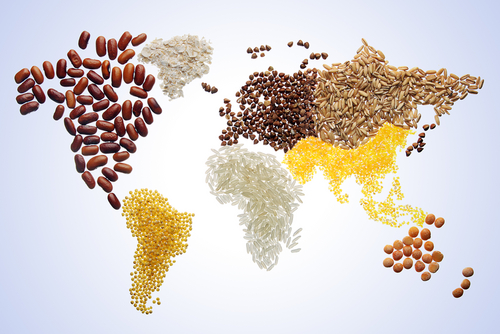
 Here are Item 11 foods you cannot afford to miss to eat to connect to Africa through Ghana.
Here are Item 11 foods you cannot afford to miss to eat to connect to Africa through Ghana.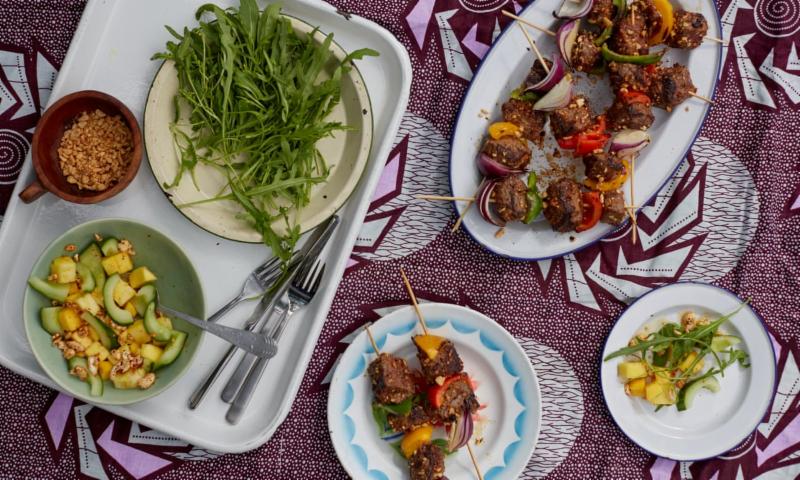
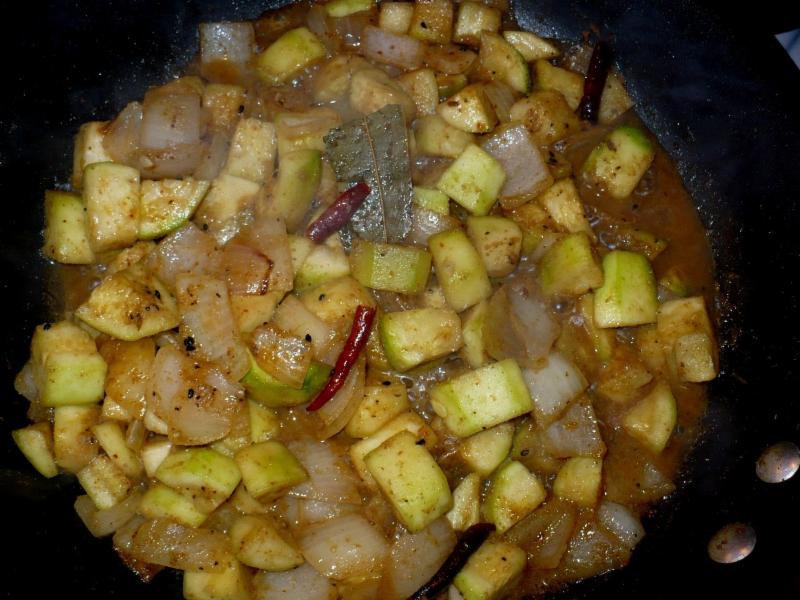 1) The lyrically named Chichinga is a very popular, essentially Ghana's answer to shish kebab: meat that has been rubbed in spice mix, then skewered and grilled. The spice mix is a blend of peanuts, ground spices and hot pepper. Suya is also the word that refers to this delicacy. Ask Nigerians - in fact, all ECOWASians plus Cameroon about suya/soya. In the Diaspora, there cannot be enough. It is the first to go out of supply at parties.
1) The lyrically named Chichinga is a very popular, essentially Ghana's answer to shish kebab: meat that has been rubbed in spice mix, then skewered and grilled. The spice mix is a blend of peanuts, ground spices and hot pepper. Suya is also the word that refers to this delicacy. Ask Nigerians - in fact, all ECOWASians plus Cameroon about suya/soya. In the Diaspora, there cannot be enough. It is the first to go out of supply at parties.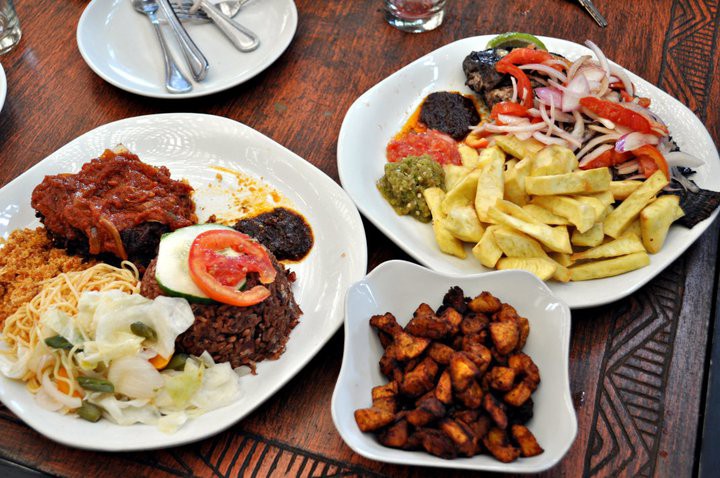
 2) Kelewele - Fried Plantains in first picture -(right down) in common and spicy in second picture, is a delicacy eaten with other meals.
2) Kelewele - Fried Plantains in first picture -(right down) in common and spicy in second picture, is a delicacy eaten with other meals. 3) Groundnut soup: There are different styles in Africa, especially in West Africa. And there you go with the famous fufu. No fufu is not African!
3) Groundnut soup: There are different styles in Africa, especially in West Africa. And there you go with the famous fufu. No fufu is not African!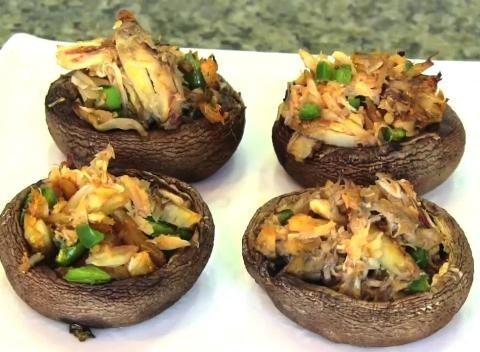
4) Akotonshi is a delectable stuffed crab dish and an appetizer. Please, never use imitation crab, it will not work in this dish. Do the real thing! The crab is mixed with an array of spices, tomato and bread crumbs is simply delicious, Enjoy! 5) Shoko Ghanaian Beef and Spinach Stew is a combination of red tomatoes and peppers with the leafy green spinach - a feast for the eyes and really, really delicious. Depending on your love for the taste, it can be slightly spicy to extremely hot.
5) Shoko Ghanaian Beef and Spinach Stew is a combination of red tomatoes and peppers with the leafy green spinach - a feast for the eyes and really, really delicious. Depending on your love for the taste, it can be slightly spicy to extremely hot.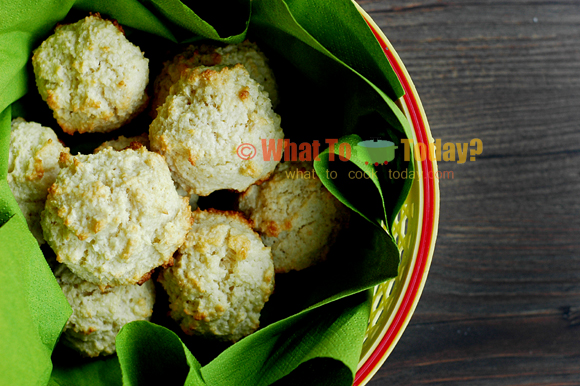 6: Garri Biscuit is a typical and popular Ghanaian snack made of cassava, eggs, milk, nutmeg, and flour baked together in the Ghanaian way.
6: Garri Biscuit is a typical and popular Ghanaian snack made of cassava, eggs, milk, nutmeg, and flour baked together in the Ghanaian way. 7) Strawberry Fool - Ghana. The term FOOL (also Egyptian for lentils) comes from the English and means essentially a fruit puree folded into a soft custard or whipped cream. You may also have vanilla pudding. There are apparently 3 African FOOLS: Strawberry (Ghana), Peach (Liberia) & Peanut (Nigeria). Make Merry, Enjoy!
7) Strawberry Fool - Ghana. The term FOOL (also Egyptian for lentils) comes from the English and means essentially a fruit puree folded into a soft custard or whipped cream. You may also have vanilla pudding. There are apparently 3 African FOOLS: Strawberry (Ghana), Peach (Liberia) & Peanut (Nigeria). Make Merry, Enjoy! 8) Waakye, deliciously Ghana, cooked with beans - it depends on the cook - but kidney beans is popularly used. The rice and beans can be served with either meat or fish, vegetables and fried plantain.
8) Waakye, deliciously Ghana, cooked with beans - it depends on the cook - but kidney beans is popularly used. The rice and beans can be served with either meat or fish, vegetables and fried plantain.
 9) Red-Red is a hearty, tasty, and no fuss vegetarian black-eyed peas stew - African Style. The recipe of Ghana's red-red is tomato stew made with black-eyed peas, palm oil, and tomatoes. Red-red gets its name from the red color of the ingredients - the red palm oil, the red tomatoes.
9) Red-Red is a hearty, tasty, and no fuss vegetarian black-eyed peas stew - African Style. The recipe of Ghana's red-red is tomato stew made with black-eyed peas, palm oil, and tomatoes. Red-red gets its name from the red color of the ingredients - the red palm oil, the red tomatoes. 10) Banku and Tilapia is made from corn and cassava dough for the Banku, served with grilled tilapia and either stew, shito or pepper. It is a highly nutritional meal with Banku being a high energy food and Tilapia comes healthy and rich in protein.
10) Banku and Tilapia is made from corn and cassava dough for the Banku, served with grilled tilapia and either stew, shito or pepper. It is a highly nutritional meal with Banku being a high energy food and Tilapia comes healthy and rich in protein. 11: Jellof Rice! Here comes Ghana. Please do not start the race among Member States.Also called Jollof rice, it packs a powerful punch in the taste stakes, but its origins are a point of contention with many African nations claiming it as their own. So much so that online wars are ongoing to protect it.In West Africa, sacred Jollof rice is a fragrant dish that is revered across the sub-region for its unique sweet taste and subtle spiciness. It is also the source of heated discussion online among Nigerians, Ghanaians and Senegalese as to who owns the bragging rights to the dish. However, in order to understand the magic of Jollof or who can rightfully lay claim to it, first its history must be understood.Jollof is believed to have originated in the Senegambia region of West Africa among the Wolof people, where it is known as benachin. The mouth-watering meal has travelled throughout the sub-region because of the frequent cultural exchange that goes on there. As such, it has evolved into several regional varieties, laced with the heritage of the place where it is prepared. Nevertheless, it maintains its magic and is relished all over Africa. By Hakeem Adam.Now, you may take a tour of taste of the African Heritage. Another great lesson and re-connection of Africa and Historical African Diaspora through gastronomy comes at the end. Let us broaden the conversation. It is farmer's time.But caution: Africa is interrelated with a lot of commonalities and not simply as products of colonial partitions. So you will finds similar foods and people speaking the same dialects. For examples:
11: Jellof Rice! Here comes Ghana. Please do not start the race among Member States.Also called Jollof rice, it packs a powerful punch in the taste stakes, but its origins are a point of contention with many African nations claiming it as their own. So much so that online wars are ongoing to protect it.In West Africa, sacred Jollof rice is a fragrant dish that is revered across the sub-region for its unique sweet taste and subtle spiciness. It is also the source of heated discussion online among Nigerians, Ghanaians and Senegalese as to who owns the bragging rights to the dish. However, in order to understand the magic of Jollof or who can rightfully lay claim to it, first its history must be understood.Jollof is believed to have originated in the Senegambia region of West Africa among the Wolof people, where it is known as benachin. The mouth-watering meal has travelled throughout the sub-region because of the frequent cultural exchange that goes on there. As such, it has evolved into several regional varieties, laced with the heritage of the place where it is prepared. Nevertheless, it maintains its magic and is relished all over Africa. By Hakeem Adam.Now, you may take a tour of taste of the African Heritage. Another great lesson and re-connection of Africa and Historical African Diaspora through gastronomy comes at the end. Let us broaden the conversation. It is farmer's time.But caution: Africa is interrelated with a lot of commonalities and not simply as products of colonial partitions. So you will finds similar foods and people speaking the same dialects. For examples:- Ewe people are indigenous to Ghana, Togo and Benin;
- The Kwa language is spoken in the south-eastern part of Ivory Coast, across southern Ghana, and in central Togo;
- Hausas are indigenous to Ghana, Nigeria, Niger, Cameroon, Togo.
- Dagaare is spoken in the Upper Western Region of Ghana and Burkina Faso.
- Kasem is spoken Eastern Region of Ghana and Burkina Faso.
- Nzema people are southwestern Ghana and southeast Ivory Coast.
Notice: Almost all the countries have French as the official language yet share indigenous cultures with English speaking Ghana.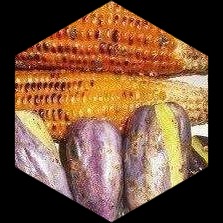 Today's roasted corn and plum, popular in parts of West Africa
Today's roasted corn and plum, popular in parts of West Africa From the American South - Collard Greens
From the American South - Collard Greens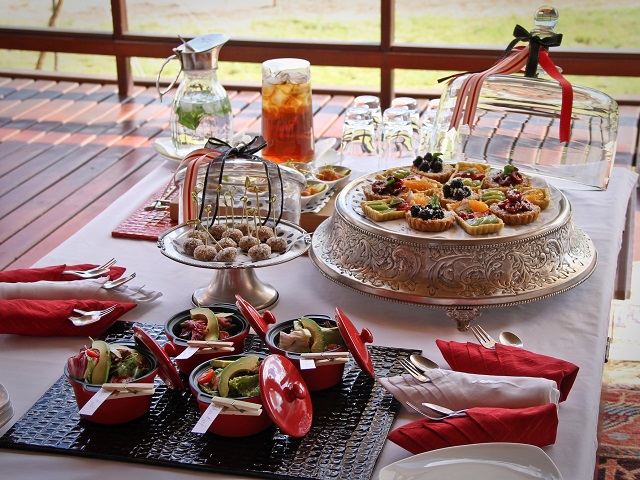
 In July 2015, President Obama visited the Faffa Food plant in Addis Ababa, Ethiopia. The US supported the plant through its Feed the Future Initiative.
In July 2015, President Obama visited the Faffa Food plant in Addis Ababa, Ethiopia. The US supported the plant through its Feed the Future Initiative. American Southern Cuisine
American Southern Cuisine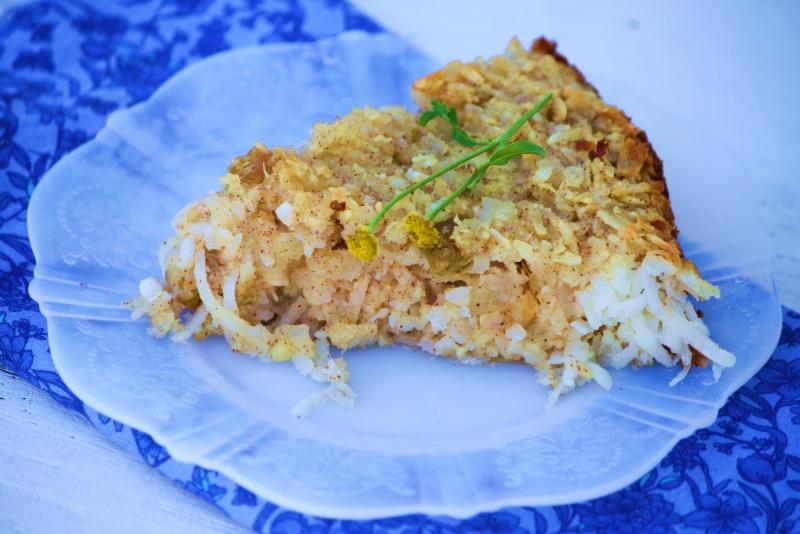 Suriname Cake
Suriname Cake From Swaziland
From Swaziland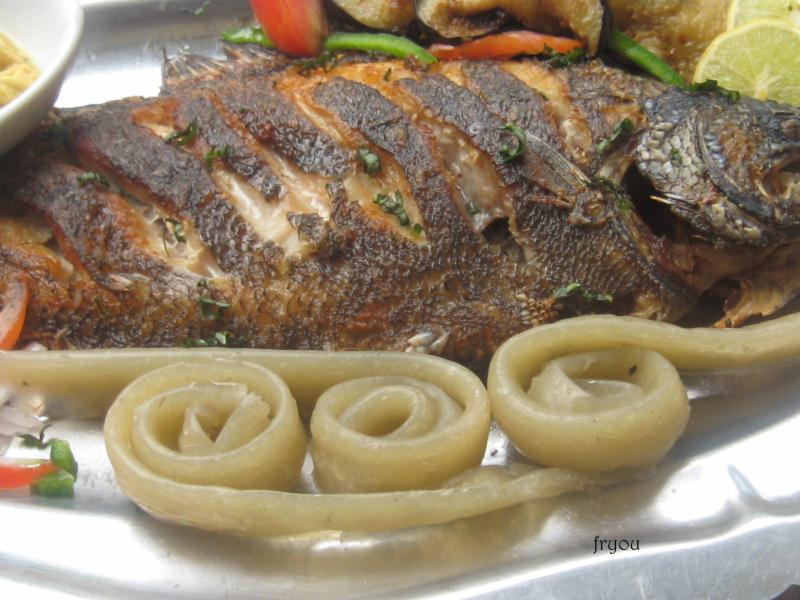 Of Cameroon! Grilled Fish and Miondo made of Cassava
Of Cameroon! Grilled Fish and Miondo made of Cassava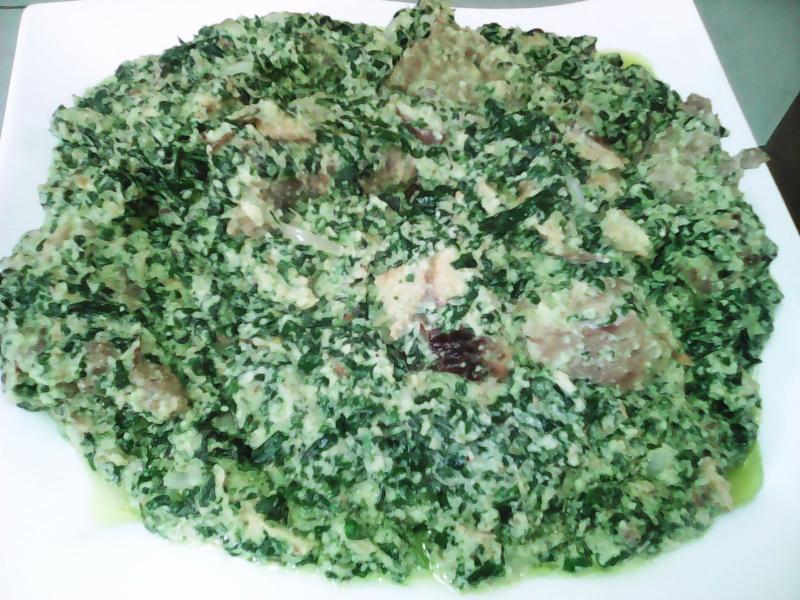 Ndole (vegetable) a specialty of the Littoral Region, Cameroon
Ndole (vegetable) a specialty of the Littoral Region, Cameroon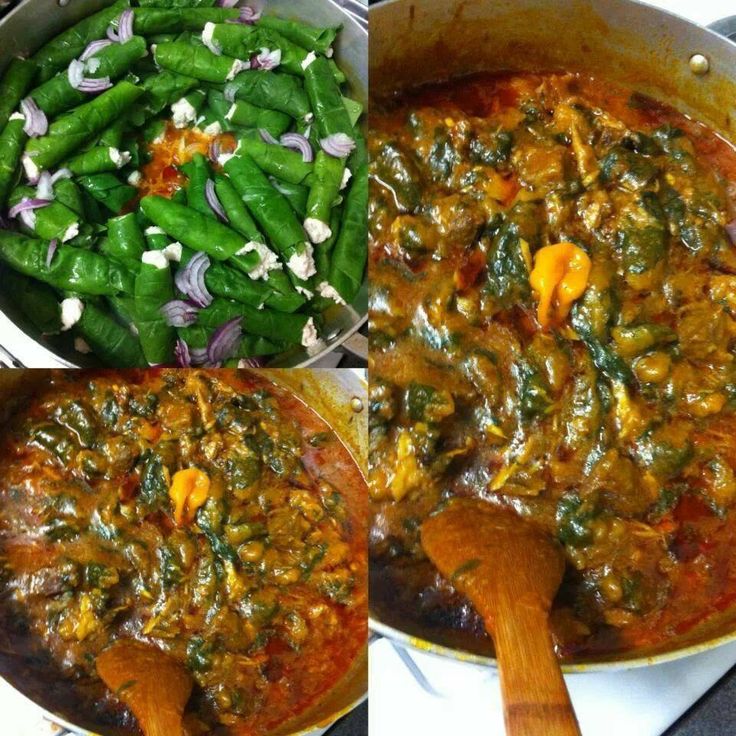 Ekwang with cocoyams, from Manyu, South West Region, Cameroon
Ekwang with cocoyams, from Manyu, South West Region, Cameroon Kwacoco with cocoyams, Fako, South West Region, Cameroon
Kwacoco with cocoyams, Fako, South West Region, Cameroon Kachumbari is popular throughout Malawi, the Warm Heart of Africa and the African Great Lake. It is made with onions, tomatoes and spicy chili peppers and usually eaten on its own.
Kachumbari is popular throughout Malawi, the Warm Heart of Africa and the African Great Lake. It is made with onions, tomatoes and spicy chili peppers and usually eaten on its own. Mbatata: Sunrise Biscuit from Malawi.
Mbatata: Sunrise Biscuit from Malawi.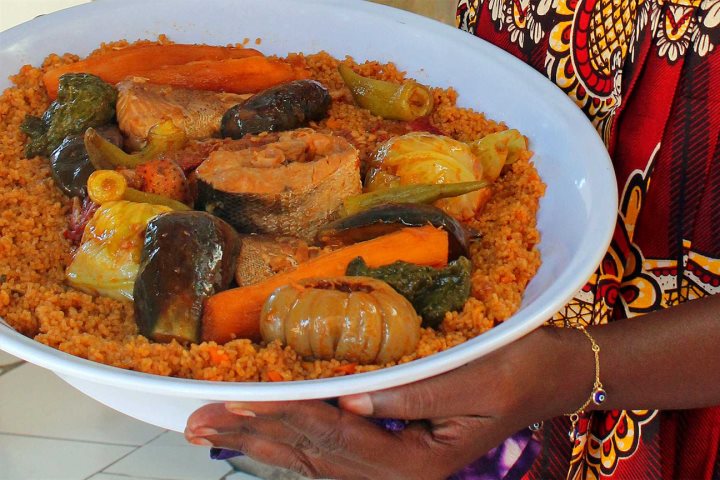 From Gambia, the Smiling Coast of Africa
From Gambia, the Smiling Coast of Africa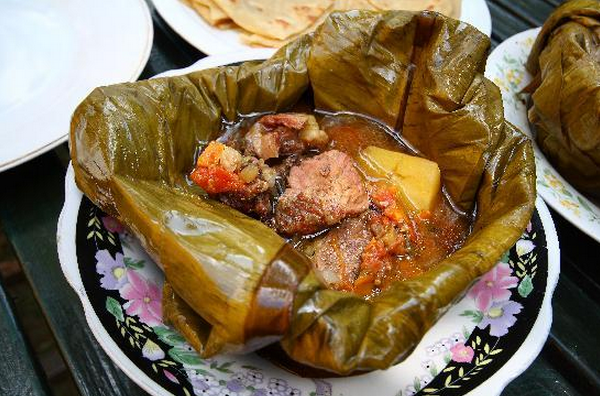 Luwombo, from Uganda, the Pearl of Africa
Luwombo, from Uganda, the Pearl of Africa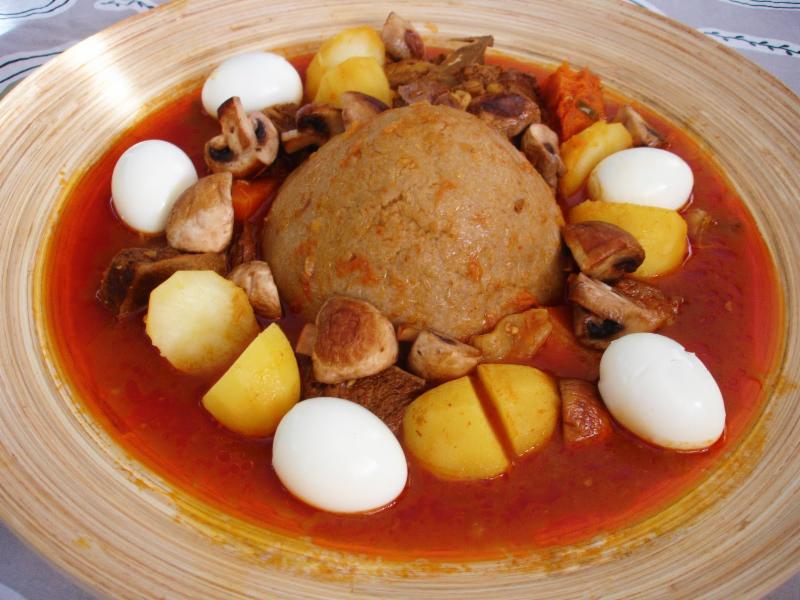 Bazeen- Libya
Bazeen- Libya Ugali, Kenya
Ugali, Kenya
 African Palm Wine being collected
African Palm Wine being collected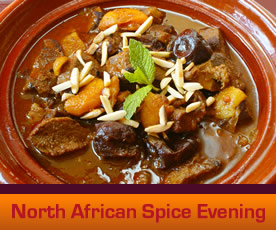 African Wine
African Wine
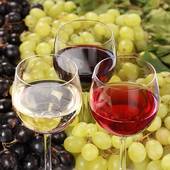
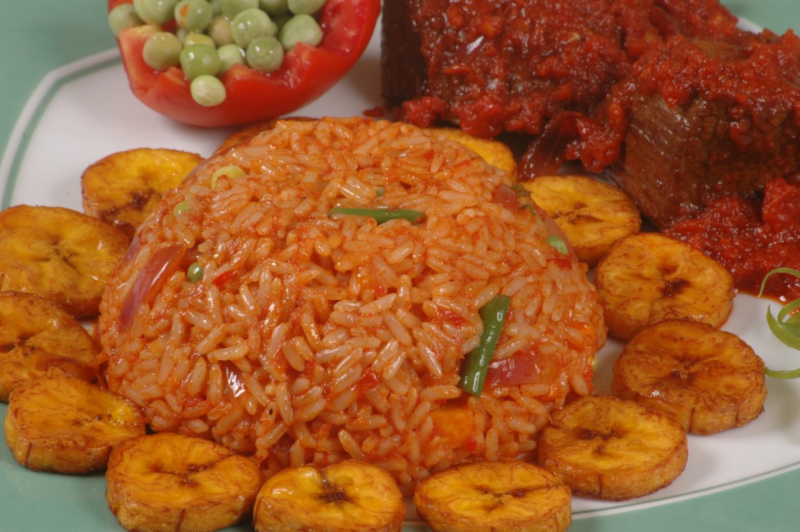 See the Jollof Rice and Plantains, popular in West Africa
See the Jollof Rice and Plantains, popular in West Africa Suya/Soya - for real
Suya/Soya - for real Attieke, Ivory Coast
Attieke, Ivory Coast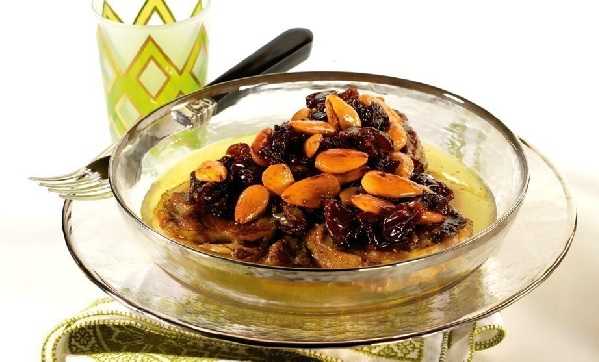 Mrouzia - Morocco
Mrouzia - Morocco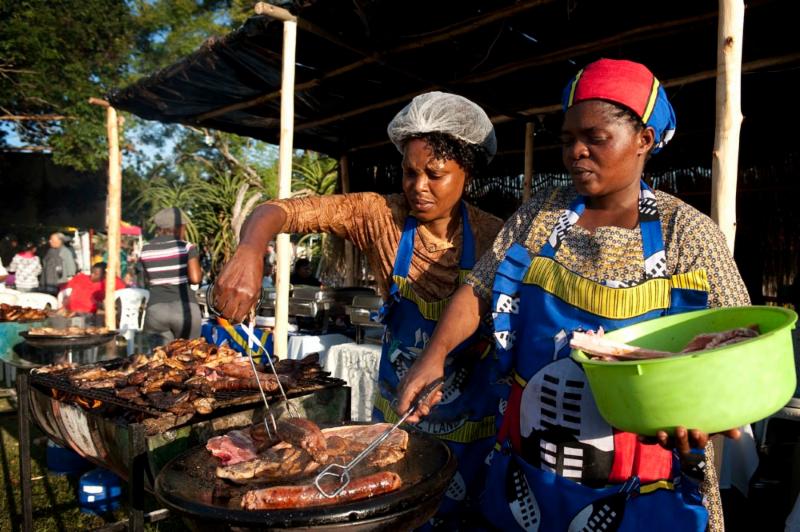 Swaziland delicacies in Europe todaySoul Food - American American
Swaziland delicacies in Europe todaySoul Food - American American
 Go Jamaica
Go Jamaica Barbados Coucou
Barbados Coucou It is called do-do or friend plantains in Africa
It is called do-do or friend plantains in Africa Bourmassa (sweet beignet) from Burkina Faso, Land of Upright Men. It is also called puff-puff in other African countries
Bourmassa (sweet beignet) from Burkina Faso, Land of Upright Men. It is also called puff-puff in other African countries A human interest story from the National Geographic puts this segment in perspective. Cornelia Walker Bailey, while growing up in Sapelo Island, Georgia, USA, never thought of red peas as anything special. Sapelo Island is a state-protected Island with about 50 residents, primarily descendants of African slaves who settled there after slavery was outlawed and is reachable only by air or boat, with the primary ferry coming from the Sapelo Island Visitors Center.
A human interest story from the National Geographic puts this segment in perspective. Cornelia Walker Bailey, while growing up in Sapelo Island, Georgia, USA, never thought of red peas as anything special. Sapelo Island is a state-protected Island with about 50 residents, primarily descendants of African slaves who settled there after slavery was outlawed and is reachable only by air or boat, with the primary ferry coming from the Sapelo Island Visitors Center.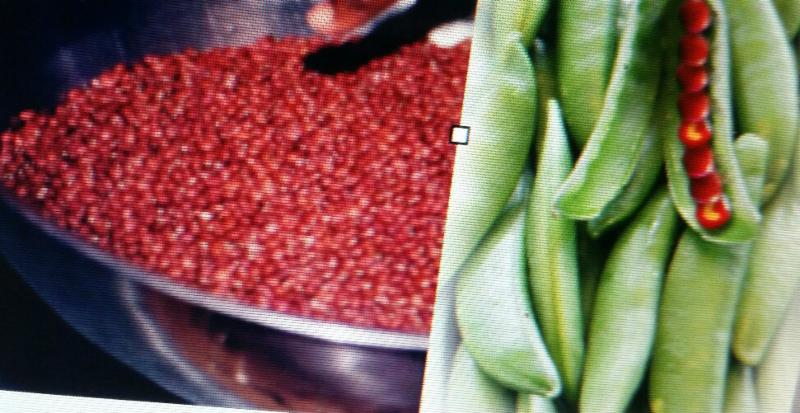 In the Bailey household, the tiny red legume (beans), with its thin, firm, sweet, buttery flavor was just another staple she and her family planted, harvested, and cooked.Well, the significance is that the red pea originated from Africa, is the original ingredient in the region's quintessential rice-and-beans dish "Hoppin' John" and just one of the many heritage crops from Africa receiving new attention from farmers, chefs, scientists, and food historians. An increasing number of researchers, most of them African-Americans, are bringing to light the uncredited ways that slaves and their descendants have shaped American cuisines and how Americans eat."We Eat This Back Home"
In the Bailey household, the tiny red legume (beans), with its thin, firm, sweet, buttery flavor was just another staple she and her family planted, harvested, and cooked.Well, the significance is that the red pea originated from Africa, is the original ingredient in the region's quintessential rice-and-beans dish "Hoppin' John" and just one of the many heritage crops from Africa receiving new attention from farmers, chefs, scientists, and food historians. An increasing number of researchers, most of them African-Americans, are bringing to light the uncredited ways that slaves and their descendants have shaped American cuisines and how Americans eat."We Eat This Back Home" One of the researchers is Atlanta chef Linton Hopkins, who has created several ways to cook and serve peas at his acclaimed southern-upscale Restaurant Eugene, including his version of Hoppin' John. Bailey indicated her favorite way to eat peas is in a traditional dish with stewed meat and okra, another plant that originated from Africa. "I had quite a few okra dishes when I went to West Africa. They had it in stews and stuff-very, very similar to what we eat here," she says. "The strange dishes they were serving us weren't strange to me, because I was going, 'Hey, we eat this back home.'"
One of the researchers is Atlanta chef Linton Hopkins, who has created several ways to cook and serve peas at his acclaimed southern-upscale Restaurant Eugene, including his version of Hoppin' John. Bailey indicated her favorite way to eat peas is in a traditional dish with stewed meat and okra, another plant that originated from Africa. "I had quite a few okra dishes when I went to West Africa. They had it in stews and stuff-very, very similar to what we eat here," she says. "The strange dishes they were serving us weren't strange to me, because I was going, 'Hey, we eat this back home.'"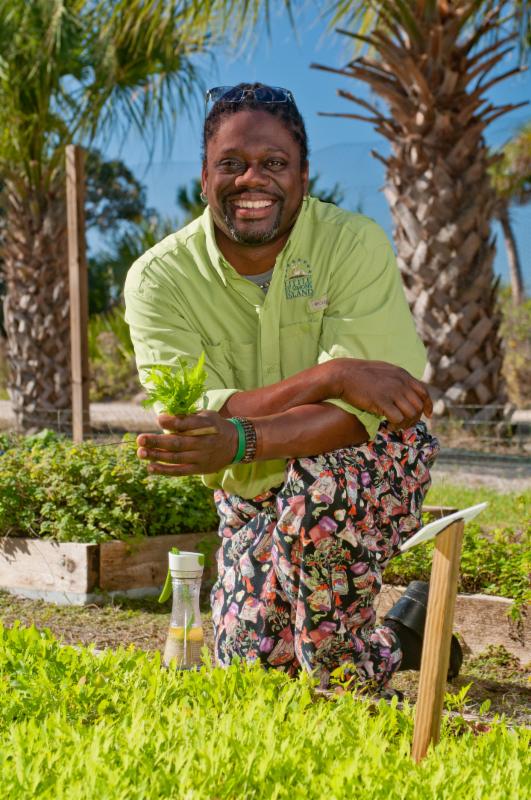 CheFarmer Matthew RaifordGeorgia chef and farmer Matthew Raiford is able to reconstruct his family's past through his farm, which has been in his family since 1874. Called CheFarmer Matthew Raiford, he coined the term "CheFarmer," merging of words "chef" and "farmer."
CheFarmer Matthew RaifordGeorgia chef and farmer Matthew Raiford is able to reconstruct his family's past through his farm, which has been in his family since 1874. Called CheFarmer Matthew Raiford, he coined the term "CheFarmer," merging of words "chef" and "farmer."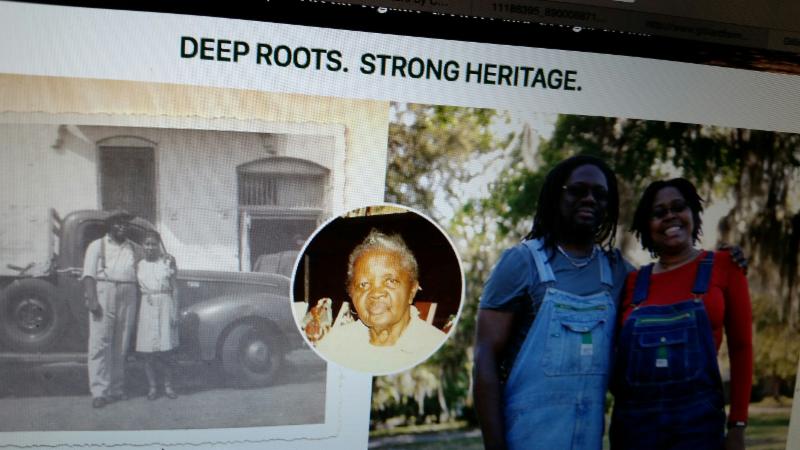 Picture Credit: Gilliard Farms, LLCCheFarmer Matthew Raiford is currently the Executive Chef of Little St. Simons Island a private resort located off the coast of Georgia accessed only by boat.He returned home to Brunswick, Georgia to become the sixth generation farmer on his families' land that they have owned since 1874. Gilliard Farms, LLC is a Georgia Centennial Family Farm.Raiford keeps a yellowed letter, a rare piece of history addressed from his great-grandmother to his grandmother, detailing how and where to plant corn, sweet potatoes, sugar cane, and watermelon. His great-great-great grandfather Jupiter Gilliard, the man who purchased the farm, was born a slave in 1812. "It's important to continue this conversation, about who brought what [to America] and why we eat what [we eat]," he says. "Those conversations need to happen so everyone has a voice at the table."Bailey, back on Sapelo, agrees. "Everybody needs to keep in touch with their ancestors, and through food is one of the best ways to get close," she says. "They could have been gone 300 years ago, but to say my great-great-great-grandparents used to use this and cook this and plant this, that gives you a good feeling."In interviews about agriculture, Raiford points out that the United States was built via the labor of black farmers - like his ancestors. "The Africans who were brought to America brought with them a plethora of agricultural knowledge and that knowledge was at the foundation of how early America was able to survive," he says."Without food, no nation will rise and this country's food system, from rice to sugar, was not only harvested by black farmers, but cultivated using their knowledge of how and when to plant; how much to water and what irrigation system to set up; what the soil was missing; and how much to add of what we now call organic fertilizer (horse, cow, chicken manure). All that was done by black farmers."Milestones and events to be celebrated in terms of historic Africa- American contribution to agriculture in America, he says, include:Frederick McKinley Jones in 1949 received a patent for refrigerated trucks to be able to move produce across country.In 1987, agricultural professor Dr. Booker T. Whatley wrote the handbook, "How to make $100,000 farming 25 acres" that addressed crop diversification, U-Pick farms and creating what he called "Clientele Membership Club" - now known as CSA or Community Supported Agriculture - and all of which have become buzz-words today.Today, Continental Africans bring along African cuisines and
Picture Credit: Gilliard Farms, LLCCheFarmer Matthew Raiford is currently the Executive Chef of Little St. Simons Island a private resort located off the coast of Georgia accessed only by boat.He returned home to Brunswick, Georgia to become the sixth generation farmer on his families' land that they have owned since 1874. Gilliard Farms, LLC is a Georgia Centennial Family Farm.Raiford keeps a yellowed letter, a rare piece of history addressed from his great-grandmother to his grandmother, detailing how and where to plant corn, sweet potatoes, sugar cane, and watermelon. His great-great-great grandfather Jupiter Gilliard, the man who purchased the farm, was born a slave in 1812. "It's important to continue this conversation, about who brought what [to America] and why we eat what [we eat]," he says. "Those conversations need to happen so everyone has a voice at the table."Bailey, back on Sapelo, agrees. "Everybody needs to keep in touch with their ancestors, and through food is one of the best ways to get close," she says. "They could have been gone 300 years ago, but to say my great-great-great-grandparents used to use this and cook this and plant this, that gives you a good feeling."In interviews about agriculture, Raiford points out that the United States was built via the labor of black farmers - like his ancestors. "The Africans who were brought to America brought with them a plethora of agricultural knowledge and that knowledge was at the foundation of how early America was able to survive," he says."Without food, no nation will rise and this country's food system, from rice to sugar, was not only harvested by black farmers, but cultivated using their knowledge of how and when to plant; how much to water and what irrigation system to set up; what the soil was missing; and how much to add of what we now call organic fertilizer (horse, cow, chicken manure). All that was done by black farmers."Milestones and events to be celebrated in terms of historic Africa- American contribution to agriculture in America, he says, include:Frederick McKinley Jones in 1949 received a patent for refrigerated trucks to be able to move produce across country.In 1987, agricultural professor Dr. Booker T. Whatley wrote the handbook, "How to make $100,000 farming 25 acres" that addressed crop diversification, U-Pick farms and creating what he called "Clientele Membership Club" - now known as CSA or Community Supported Agriculture - and all of which have become buzz-words today.Today, Continental Africans bring along African cuisines and produce from coffee to cassava. African ethnic crops are included in formal curricula in many schools. For example, at the University of the District of Columbia - UDC. Pictured above is UDC's Ethnic Crop Specialist Prof. Yao Afantchao (above).
produce from coffee to cassava. African ethnic crops are included in formal curricula in many schools. For example, at the University of the District of Columbia - UDC. Pictured above is UDC's Ethnic Crop Specialist Prof. Yao Afantchao (above).  The famed Ethiopian Coffee Ceremony
The famed Ethiopian Coffee Ceremony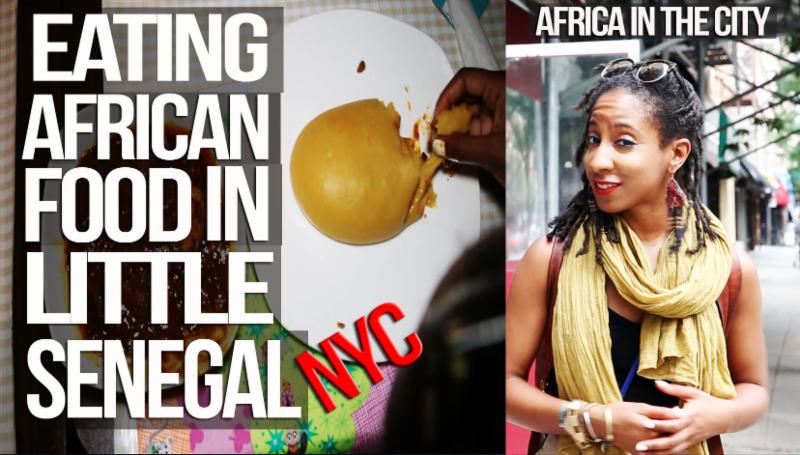 In New York, USA
In New York, USA
 South African delicaciesFeast on Kenyan delicacies in the Diaspora
South African delicaciesFeast on Kenyan delicacies in the Diaspora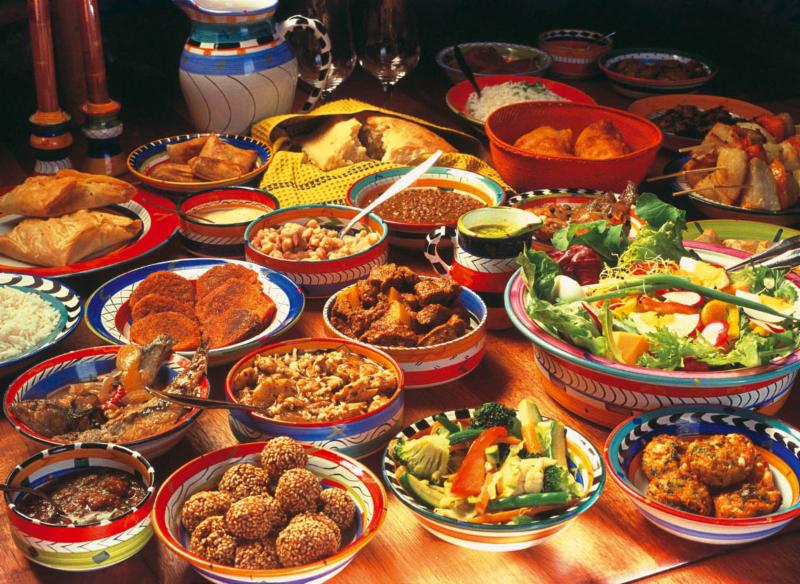
 Accara from Africa
Accara from Africa Sadza ne Nyama ye Huku "Zimbabwean Porridge with Chicken Stew
Sadza ne Nyama ye Huku "Zimbabwean Porridge with Chicken Stew Daube Stew with lamb in Seychelles
Daube Stew with lamb in Seychelles

 African Union Citizen: Actualizing Agenda 2063, 7915 24th Place, Hyattsville, MD 20783Sent by africanservices@aol.com in collaboration with
African Union Citizen: Actualizing Agenda 2063, 7915 24th Place, Hyattsville, MD 20783Sent by africanservices@aol.com in collaboration with
Try email marketing for free today! 
- ,
- or
AD


